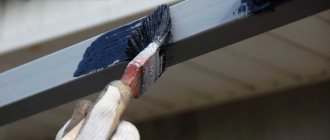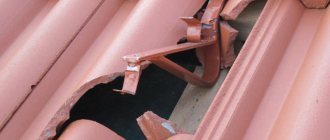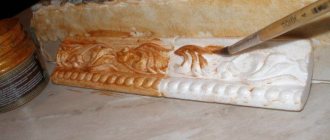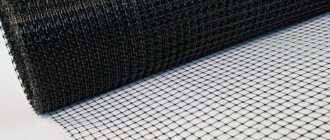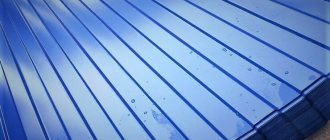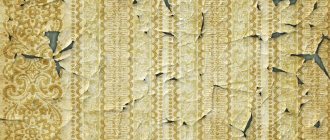Chain-link fencing has still not lost its relevance. This is due to the fact that such a fence is easy to manufacture, inexpensive and, in addition, does not obscure the land area. But, over time, it may undergo corrosion, which will raise the question of painting it.
We will now tell you how to paint chain-link mesh correctly.
Rabitz
How to quickly paint a chain-link fence: 4 easy ways
Chain-link fences are the most common in the private sector, especially in dacha (garden) areas. The owners focus mainly on the cheapest version of the chain-link – metal products without zinc coating. If you do not carry out additional processing (painting), then such a light-type fence will not serve for a long time - its frequent repairs (and, in fact, regular patching of holes) are ensured. What and how it is more convenient to paint a chain-link mesh is the topic of this article.
Preparation
The question of the content of this stage is quite controversial, since taking into account the specific design of the chain-link, many technological operations are often neglected by the owners. For example, cleaning rust from a mesh is quite a troublesome task, and not everyone has the patience to complete it, especially if the perimeter of the area is large enough. Therefore, preparation, as a rule, comes down to degreasing, in individual areas. By the way, in order to avoid preparation, it is best to paint the mesh immediately after attaching it to the posts.
Coloring
Explaining to the reader how to work with this or that tool is pointless. But it’s worth dwelling on the features of various methods of coloring chain-link. They are applicable for applying both primer and base composition.
Brush
If you work carefully, the paint consumption will be small, although some of it will be spilled on the ground. But this process takes time and effort.
Spray gun
Plus – high speed and quality (uniformity) of coloring.
Cons – there are many more of them.
- You will need compressed air, and the compressor is not a household unit. High consumption of paint and varnish composition. The complexity of the operations, since you will constantly have to “keep” the angle of inclination of the jet to the grid at about 45º. Changing it increases paint consumption.
Mitten
The method is quite exotic, but quite effective.
The mitten must be turned out, and in order not to stain your hands, it is advisable to use rubber (thin) gloves. Everything else is simple - dip it in a container and apply paint to the mesh. In this case, it is necessary to take into account the type of paint. If there is a solvent in it, then the rubberized glove will not last long - it will “float” right on your hand. But in the case of oil-based paints, this is a good option.
Roller
This technology for painting mesh netting is considered the best. And if 2 people work, painting simultaneously on both sides, synchronously and symmetrically, it will take a minimum of time, and the paint consumption will be optimal.
- A more uniform coverage of the mesh is ensured by a long-pile device. In order to use the paint flowing down in the future, you should work with a “screen” (sheet of metal, plastic, plywood), on which drops and smudges will collect.
Well, which design option for a mesh fence to choose is up to you, dear reader. Good luck in improving the fence!
Preparation
Before you start painting, the surface should be thoroughly treated. Using a wire brush, carefully go over all sections, removing any rust or dirt. The next stage is degreasing. Treat the surface of the mesh with a special solvent. After which a primer is applied. It promotes excellent adhesion of paint to metal.
Methods for painting a chain-link fence
There are three main methods tested by summer residents:
- Painting the fence with a roller or brush;
- Spray painting;
- Painting with a fur mitten.
Let's look at each of the methods.
The advantage of using a brush is that you can reach hard-to-reach places. Otherwise, this is not the most efficient solution:
- A lot of time and effort will go into painting only one side of the fence. And this is without re-processing. Plus the second side.
- Not economical paint consumption. By the time you bring the brush to the mesh, a lot of material will already be lost. And how much will drain from the cells, not to mention the fact that drops and drips will collect on them;
- The fence takes a long time to dry. Due to paint accumulation and thickening of the cells, the fence takes much longer to dry. This increases the risk of accidentally staining clothing or body parts.
Article on the topic: Is it possible to mount sip panels horizontally
The most acceptable way, especially if you have a partner.
- Allows you to paint both sides simultaneously with less time;
- It is better to take a roller with long pile for high-quality coloring of the cells;
- First, go over the palette with a roller so that the paint does not drip;
- More economical material consumption.
Allows you to quickly get the job done. To do this, you need to hold the tool at an angle of 30-50 degrees so that the paint gets onto the mesh as much as possible. However, this method also has its drawbacks:
- A lot of wasted paint. At the same time as the fence, you will paint the grass, plants, and nearby buildings. To avoid this, use a thick shield that is installed on the other side of the painting;
- To carry out the work, the use of protective clothing is necessary.
Using a fur mitten
A homemade method that you can test too. You will need a mitten with the fur turned outward. For protection, put on a thick rubber glove and then a mitten. Dipping your hand into the paint, paint over the chain-link mesh. The open question remains: how effective is this and how many mittens are needed when painting a 20-meter fence? But you will definitely be sure that each cell is painted.
Man has not yet come up with more effective methods. You can fully express your imagination and enthusiasm. Please note that purchasing high-quality fencing material once will cost less than painting it every 2-3 years.
How to paint a chain-link fence on a fence
Chain-link mesh is a good material for budget fencing. But over time, the mesh may lose its attractive appearance and become subject to corrosion. In the hope of giving the fence its previous appearance, the owner of the property wants to paint it directly on the fence. You can find many instructions on the Internet on how to paint a chain-link fence on a fence. But our advice is that there is no need to paint the mesh . Suddenly? Then read on.
There is an opinion that the chain-link mesh can be painted with a spray gun, mitten, roller or brush. All these articles were written by people who have never carried out painting work.
- the spray gun is a huge waste of money, a lot of paint falls on the ground, polluting your own and your neighbor’s property. The sheets offered will not help; the paint will fly in different directions;
- mitten is a more economical method, but it is extremely unproductive and causes unpainting. After 20-30 minutes you will get tired of this idea;
- roller - massive unpainting, faster than a mitten, but slower than a spray gun. Large overrun;
- a brush is a huge waste, because all the paint will flow down the mesh.
And then you ask: “So what to do? Don’t paint it at all?” Namely, the chain-link mesh on the fence does not need to be painted. You will spend a lot of nerves, effort, time, money, in the end. And what in return? The paint will peel off in a year. And in a year you will have to paint again.
The most expensive part of a chain-link fence is the posts and their installation. The chain link itself costs 70-100 rubles per meter depending on the height in galvanized version, 150-200 rubles per meter with a polymer colored coating. Installation of chain-link on poles - 70-120 rubles per meter. Thus, for 150 rubles/linear meter you will get a new fence that will last for ten years!
But if you really want to paint the chain-link fence on the fence, we won’t dissuade you. Painting methods are described above.
Mitten
The method is quite exotic, but quite effective. The mitten must be turned out, and in order not to stain your hands, it is advisable to use rubber (thin) gloves. Everything else is simple - dip it in a container and apply paint to the mesh.
In this case, it is necessary to take into account the type of paint. If there is a solvent in it, then the rubberized glove will not last long - it will “float” right on your hand. But in the case of oil-based paints, this is a good option.
[my_custom_ad_shortcode5]
How to paint a chain-link
20.06.2014 08:40
Currently, chain-link fences are becoming more and more popular. And there is nothing to be surprised here: after all, it is easy to install, and the cost, compared to other materials, is not so high. A chain-link fence looks good, the mesh is reliable, and the space looks open. If you decide to install a chain-link fence around your house, then after a while you will be faced with the question: “How to paint a chain-link fence?”
Some owners are occupied with this question even at the stage of installing the fence, while others begin to think when, after some time, conspicuous rust spots appear on the metal mesh.
First of all, it is worth noting that the need and methods for painting the mesh depend on its composition and where the painting is done: still in a roll or already on an installed fence.
Is the chain-link galvanized or non-galvanized?
If you purchased a galvanized chain-link , then painting is out of the question. Its appearance does not require additional processing. It already looks excellent, because air humidity, rain, and sun do little damage to it.
But the non-galvanized mesh will soon require painting from the owners, as it will become rusty. Which coloring method should I choose?
Painting a chain-link fence
1. The first method can be called “fur mitten” . Take a fur mitten, first turning it inside out. Dip in paint and paint each cell. The activity is long-lasting, but the effect of the work is amazing.
2. For the second method you will need a roller or paint brush . With a brush you can reach all the twisted places, and the paint goes on smoothly. But the work again takes a lot of time, and the paint may leave frozen smudges in the form of drops.
You can paint the chain-link using a roller. It is better to use fur coats, and the pile should be long. Lightly dip the roller in paint. This will allow you to apply it evenly, and there will be no splashes around the fence (save paint). To obtain high-quality coloring, it is better to do this work together, simultaneously painting the same place on both sides. In this case, the mesh will be enveloped, the paint will not spread, and the surface will be painted evenly.
3. If you have a spray gun , you can use it to paint the fence. Working with it, you will significantly reduce your time costs. But this method has a big disadvantage: when working with a spray gun, paint consumption increases. But by installing the screen on the other side of the fence, less material will be required for painting. As you progress, the screen needs to be moved. In addition, you will see that the mesh on the other side is already partially painted. Adjust the fence on the other side, again using the screen. Corrugated cardboard is perfect for it.
How to paint a chain-link mesh in a roll
Dyeing chain link in a roll is a fairly common and convenient method. To perform this type of work, you need to stock up on:
- Use a sponge and brush to clean the metal surface.
- With a fur mitten, or a paint brush, or a roller, or a spray gun.
- Primer, paint. Moreover, it is better to select both primer and paint that are produced by the same company.
Necessary materials
Primer – enamel 3 in1
To paint a mesh fence, the same materials are used as for treating any other metal surfaces. These can be acrylic or alkyd mixtures.
To obtain a high-quality, durable coating, in addition to paint, you will also need an anti-corrosion primer. It will not only ensure a reliable connection between the coating and the metal, but will also protect it from rust.
Advice! To speed up the work, you can use primer for touch-up – 3in1 enamel. It can be applied directly to rust.
Recommendations for choosing paint, tools and methods for painting chain-link mesh
Fencing off has always been perhaps the only way to show your right to a certain territory. That is why today there are many methods and means that will help the owner avoid prying glances from neighbors, and installing a chain-link mesh is one of them.
But anyone who has ever come across this material knows for sure that over time, without proper protection, such a fence becomes unusable. And here a logical question arises: how to paint the mesh to extend its service life?
This is what the mesh painting process should look like:
How profitable is it to buy a chain-link mesh?
To begin with, it should be noted why many owners of summer cottages or houses in the private sector prefer to opt for such a means of protection as chain-link mesh.
The advantages of mesh fencing include:
- quick installation or removal;
- installation without pickets or slats (the skeleton of a fence made of beams);
- no need for reinforcement with cement or concrete mortar;
- no need for weekly monitoring;
- legality (horticultural cooperatives have recently introduced a ban on tightly fenced areas);
- saving useful space;
- unhindered penetration of sunlight and rain into areas adjacent to the fence.
But the main advantage of the mesh, of course, is its cost. Technological developments have advanced quite far and quickly, so along with a conventional mesh fence, you can also purchase a fence that is galvanized or already factory-coated with anti-corrosion polymer protection. But, as happens at the most inopportune moment, there is not enough money to buy such a mesh, so you have to be content with a cheap analogue - an ordinary chain-link made of quickly rusting ferrous metal.
It’s already very difficult to paint such a mesh
If you don’t take care of timely protection of the mesh, then after a year or a year and a half or even a couple of months, depending on the intensity of precipitation, you will have to dismantle the fence and go to the store again for a new one. To avoid such a senseless and impractical waste of money, as soon as the chain-link has been purchased, it’s time to start putting it in order, that is, painting it.
Choosing paint and tools
At first glance it may show that there is nothing simpler than painting a chain-link mesh. On the one hand, this is really true, because the mesh area is not hollow, but cellular and consists of thin wire, which eliminates the need to paint several times to paint every recess or crack. On the other hand, you should still take into account several nuances in matters of painting.
To paint the mesh, you need to select a paint intended for metal.
Firstly. Should you figure out what paint to paint? In short, any enamel or paint designed for exterior metal surfaces will do. Why can't I use paint for interior decoration? The answer is simple: it does not contain aggressive substances that can combat external climatic factors (strong wind, heavy rain, sunlight, etc.).
Aerosol paint is also suitable, but its use is only permissible as a last resort, say, if it has been drying in the pantry for a long time. Otherwise, its use is irrational due to its excessive cost and the impossibility of controlling spraying: there is always a risk of painting not only the fence, but also nearby plants or objects.
Secondly. What tools can be useful in your work? Depending on the painting method, working tools may include both a standard painting set (brush, roller, spray gun, mixture patch) and more original accessories (fur mitten).
So, the paint has been purchased, and the tools are already ready to go. But the painting stage is preceded by preliminary preparation of the surface for work.
Surface preparation
Before painting the chain-link mesh, it needs to be prepared. It doesn’t matter whether it has just been purchased or has already performed a barrier function for some time and as a result has already become covered with rust, first of all, it is important to prepare the wire for further manipulation. This is a tedious and lengthy task, so it is best to do it with four, or better yet, six hands. In order to prepare the surface, you need to have sandpaper, a degreasing liquid (for example, gasoline or acetone) and a primer on hand.
Cleaning is carried out in several stages:
- First, you should carefully rub sandpaper over each cell. Use a sanding motion to remove all old coating. This stage can be skipped if the chain-link is new or installed very recently, so it has not yet become corroded.
- Then the surface is degreased with a special solution and wait until it dries completely.
- The last step in preparing the surface for painting is priming in several layers. The second layer of primer will smooth out the flaws made at the beginning and create an additional protective barrier. This step should be skipped if further painting work will be carried out using modern metal paint.
Now you can start painting the fence itself.
Coloring methods
There are several ways to paint this kind of fence. They vary depending on the number of workers, the tool used and the method chosen. But not all of them are acceptable for reliable, fast and high-quality painting of a mesh fence.
Brush processing
This “old-fashioned” method seems to be the very first one that comes to mind, so it is not at all surprising that it is so popular among owners of private houses. It is true that with a brush you can reach hard-to-reach places, but, nevertheless, it also has a lot of disadvantages.
It is worth noting that a brush, although an acceptable tool, is far from the most effective. There are at least many reasons why it is not recommended to use such a traditional device in the painting business:
- Painting requires careful attention. It was empirically calculated that working on one side, equal to 12 m, will take on average about two days: apply one layer of paint, wait some time for it to dry, apply a second one and correct the flaws of the first layer. As a result, energy, invaluable time and nerves were wasted.
- Paint is not only not saved, but also increases in consumption. Here's how it happens: after dipping the brush into a bucket of coloring solution, on the way to the fence, the paint drips onto the ground and green spaces. A few more drops will “settle” on the clothes, and others will flow off the wire. As a result, some of the paint will be wasted.
- The paint quality suffers. No matter how carefully the work is done, the bristles of the brush will leave smudges. Also, if a bad material was used, the paint will collect in drops, forming unattractive thickenings on the cells, which, in turn, will dry for quite a long time. Therefore, it is better not to approach the fence in the next 3-4 days, otherwise you will have to think about how to wash off the beautiful ornament from your palms.
Roller processing
Painting with a roller is convenient only in situations where two people are involved. Otherwise, the flexible cellular structure of the mesh will not provide sufficient adhesion to the roller, and the paint will remain on the tool material.
Is the chain-link galvanized or non-galvanized?
If you purchased a galvanized chain-link , then painting is out of the question. Its appearance does not require additional processing. It already looks excellent, because air humidity, rain, and sun do little damage to it.
But the non-galvanized mesh will soon require painting from the owners, as it will become rusty. Which coloring method should I choose?
[my_custom_ad_shortcode5]
Methods for painting chain-link mesh
Over the years, the chain-link mesh does not lose its relevance at all.
But her appearance over the years can change beyond recognition. This is especially true for mesh netting made of ferrous metal. Some people tend to paint it immediately after installation. Someone bides his time and gets to work when corrosive phenomena - rust - begin to appear on the metal.
There are several ways to paint chain-link mesh. Each type has its own advantages and disadvantages. After reading the article, everyone will be able to choose the best painting option for themselves.
First way. The mesh is painted with a “fur mitten”. To do this, turn the mitten inside out, dip it in paint and begin the painting process. Cell by cell, section by section. This painting method will take quite a lot of time, but it guarantees high-quality painting of each mesh cell.
Second way. A brush or roller is used to apply special paint. It is more convenient, but longer, to use a brush. This will allow you to reach every bend in the wire. A roller will help you get the job done a little faster. But it is difficult to reach hard-to-reach places with it. It is recommended to select a roller with long pile. But you should put very little paint on the roller to avoid smudges. It is convenient to use a roller if two people are painting the fence - simultaneously on both sides. This will not only speed up the work process, but also improve the quality of coloring.
Third way. The fastest way is to use a spray gun. It really won’t take much time to complete the work, but the paint consumption will be quite large.
All of these methods of painting chain-link mesh involve working with an already erected fence. But you can paint the chain-link mesh in a roll. For such work you will need the help of a spray gun. A roll of material is placed in the tank and constantly rotated until completely stained.
Main types
In the construction market, thanks to modern manufacturing technologies, mesh is sold in several types:
- Galvanized.
- With anti-corrosion protection.
- An ordinary chain-link made of ferrous metal.
The cheapest from the above list is a ferrous metal mesh, but next year it will rust due to precipitation. To extend its service life, it is necessary to paint the chain-link immediately after installing the fence.
Do-it-yourself coloring of chain-link mesh
How to paint
To paint a chain-link fencing, use paints and varnishes designed to protect metal surfaces:
- alkyd paints;
- acrylic paints;
- enamels.
Considering the impact of an aggressive external environment on fences made of this material, it is recommended to use anti-rust enamels as a coating. They allow you to obtain high-quality metal protection and also reduce preparation costs.
If you are going to use conventional paint compositions, before starting work it is necessary to treat the surface with a primer with anti-corrosion characteristics.
Calculation of paint consumption
Before you paint the chain-link mesh on the fence, you need to decide on the amount of material. Paint consumption depends on the method of performing the work. Painting with rollers is considered the most economical option, but even in this case it will not be possible to avoid a large amount of wasted material.
The design feature of the chain-link implies high losses of the paint composition.
According to building codes, the minimum paint consumption when painting welded mesh and other cellular materials is 45% of the standard for painting a blank metal surface.
If for an area of 1 sq.m. According to calculations, 200 ml of paint is required (this value greatly depends on the paint itself, but it is always applied to the label, you need to start from it), then for the chain-link you will need 90 ml, while the surface of the mesh to be painted is tens of times smaller.
Coloring methods
Having calculated the required amount of paint and primer, proceed to choosing a painting method. How to paint a chain-link and save on material? In practice, four options are used:
- Using a brush. The most expensive method in terms of time and material consumption. Choose a soft brush, no more than 100 mm wide. To reduce losses, it is recommended to dip only the very tip of the tool in paint. By spreading the coloring composition over the mesh, smudges are controlled. They need to be picked up immediately with a semi-dry brush. No matter how hard you try, smudges and drops on the ground cannot be avoided when using a brush.
- Using a roller. You can quickly and efficiently paint a fence using a roller only with a partner, making synchronous movements on the inside and outside of the fence. As in the case of a brush, paint a little on the tool, carefully roll it on the ditch and, pressing the rollers on both sides to each other, roll it at the same time. Thus, all cells are completely painted.
- Using a spray gun. The most expensive method in terms of material consumption. The paint for the chain-link mesh is sprayed from a distance of 30-40 cm. In order not to stain plants and buildings with paint, it is recommended to install a barrier shield made of plywood or cardboard on the opposite side.
- Using a fur mitten. A somewhat extravagant, but effective way to work with cellular products. The fur mitten is turned inside out and used as a brush. This method is also associated with increased material consumption - the paint saturates the thick mitten, accumulating in it. To protect your hands, it is recommended to wear rubber gloves.
Materials and tools
Having decided on the painting method, we begin to purchase materials and select the appropriate tool.
You will need the following materials:
- primer for metal surfaces with corrosion protection;
- degreasing solution;
- paint (acrylic, alkyd or enamel).
- a brush with iron bristles for cleaning the mesh from rust and old paint;
- medium grit sandpaper;
- medium pile roller;
- cuvette;
- brush 100 mm wide;
- spray gun;
- a sheet of plywood or thick cardboard, when painted with a spray gun.
Iron bristle brush.
Preparatory work
Before starting work on the actual painting of the fence, you need to perform preparatory operations. The need for preliminary surface preparation depends on the condition of the mesh.
You will have to tinker with an old and rusty fence, but even a completely new chain-link needs to be treated in order to achieve a long-term effect after painting. You will need to allocate a sufficient amount of time for this work. It is better if several people are involved in the preparation at the same time.
/ mesh fencing for gardens / fences
square hole size
Q1: Is DD-Fence a trading company manufacturer?
A1: We produce metal fencing ourselves and sell other types of products.
Q2 : Where is the DD-Fence factory located?
A2: Zhaoyang County, Hebei Province, China.
Q3: How many years of manufacturing experience does DD-Fence have?
A3: 10 years.
Q4: How many years of warranty does DD-Fence offer?
A4: It depends on the use environment, DD-Fence usually offers 10 years 20 years warranty.
Q5: Does DD-Fence have technical support for installation?
A5: Yes, we have professional engineer to service installation manual.
Q8: Is DD-Fence ISO certified?
A8: Yes, our factory is ISO9001 certified.
Q6: Which countries have you exported your products to?
A6:: South Africa, Qatar, Iraq, Australia, United Arab Emirates, USA, Brazil, Turkey, Nigeria, Benin, Sudan, Bahrain, Saudi Arabia, Mozambique, Singapore, UK, Russia, Turkmenistan, Lithuania, Romania, Colombia, Cyprus , Kenya, Zambia, Uganda, Algeria, Equatorial Guinea, Mauritius, Angola and so on.
Q7: What is your payment term for a new client?
A7: Option 1: Payment via Alibaba Trade Assurance.
Option two: 30% advance payment, the balance is a copy of the letter of credit.
Option three: 100% letter of credit at sight.
Option four: Letter of credit with the right to use after 60, 90 or 120 days.
Q8: How to become a DD-Fence agent and what are the benefits?
A8: To our agent, we provide the maximum discount on our fencing products and showroom support. To apply, please send us an inquiry by email and if approved, we will sign a formal agency agreement.
.
When there are a lot of holes or how to paint a chain-link mesh with your own hands!?
Author: sTs Recording date
It so happened that in my city, with acid rain and terrible ecology, the mesh on the fence began to rust . Although, according to the manufacturer, galvanization does not need to be painted and it should last for a very long time.
First of all, I started looking for a simple solution on the Internet, but I couldn’t find how to paint the chain-link So this is the best guide in RuNet for painting the mesh yourself ! I liked the tips - put on a fur mitten and smear the paint on it or paint with rollers on 2 sides AT THE SAME TIME! But what to do if there is access only on one side and
Is there a bunch of living creatures growing over the fence?
The instructions are suitable for anyone who wants to quickly paint the mesh with minimal losses.
It’s a pity we didn’t shoot a video during the process)) But the painting process was accurately reproduced in 3D.
What is needed to paint the mesh?
— a spray gun with a nozzle size of 1.5 (I took a liter one for $15)
— compressor + receiver with a capacity of 150 l/min (cost from $100 and above. I had a pressure tank, but I couldn’t find one for sale without a receiver)
— paint + a lot of solvent (determine the consistency experimentally)
— protective equipment (a gas mask solves a lot of problems :))
- a sheet of something (with a slight wind, the paint blows in all directions, but not onto the mesh)
At what angle to the fence should I paint? Only at an angle close to a straight line. The paint didn't spill out (at least for me.)
How to paint? After experimenting a little, I came to the conclusion that you need to make three types of movements and carry them out once along each wire. It's quite fast and efficient.
What are the advantages compared to a brush/roller:
+ minimal paint consumption. The paint lays down in a thin, even layer without drips or streaks! The spray gun resulted in at least threefold savings!
+ time saving. Painting the chain-link with a roller took a lot of effort, and there were some imperfections. The reverse side should be painted with anrial. Plants get in the way all the time. The spray gun sprays paint over tens of centimeters, so you don’t need to strain too hard. The increase in productivity over time is probably tenfold!
Cons (and where would we be without them :) ):
— not that it’s a minus — but you need a long carry
- on the back side of the mesh there may be a thin unpainted area over the entire area. If you ask your neighbors, the situation will improve very quickly.
We paint the column) When painting the chain-link, this situation is NOT ACCEPTABLE!
It seems like he shared his positive experience.
Oh yes! Don't listen if someone says that you won't succeed. If you are confident in your abilities, follow firmly to the end!
Good ideas and successful implementations to everyone. Banzai!
- Tags
Author: sTs
I love homemade products. I strive for a healthy, harmonious lifestyle. I value openness and honesty in people. With my website I want to convey to young people the value of creative qualities in a person. Let everyone make new acquaintances and gain a lot of knowledge and experience that will make him a holistic person ! I tell you more about myself on my blog.
9 answers to “When there are a lot of holes or how to paint a chain-link mesh with your own hands!?”
Interesting idea. It might come in handy someday. I'll take note.
a lot of paint is wasted just like that)) and in what program were the pictures created?? I'd love to try to create something like this!
Okay, I’ll download it, I’ll try, maybe something good will come of it
and where can you remove the compressor for a homemade device? As far as I understand, the car one doesn’t work either...
Automotive saw on sale with a maximum performance of 76 l/min. This is very little. I tried painting at 160 l/min - it was barely enough at this flow rate with a 1.5 mm nozzle. I don’t even know where to remove it from) Another point - they recommend low-speed ones for longer durability (less wear). In theory, a car's small size spins at full speed.
There has been a KND-1 (low-pressure spray gun) since Soviet times (and I still see new ones on trading floors) - designed to connect to the blower of a Soviet vacuum cleaner. I painted my wheel rims with this spray gun and a 500-watt vacuum cleaner, and the flight was normal for two years. As for airbrush guns for compressors, look at the markings. For medium-sized compressors with an output air volume of up to 200 liters per minute, you need to take LVLP - low volume low pressure - low air consumption at low pressure. The operating pressure is about 3.5 atm, and there is enough air. And if you get HVLP, it simply won’t have enough air volume.
The compressor must be made from refrigerator parts... And somehow I used the spray gun myself.
I didn’t understand how to make a spray gun, but the compressor from the refrigerator turned out to be very weak.


